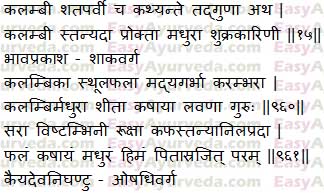Water Spinach – Uses, Qualities, Remedies, Research
By Dr Renita D’Souza
Water spinach is a nutritious vegetable used for both culinary and therapeutic proposes. It is traditionally used to treat diabetes, constipation, opium poisoning, heavy metal toxicity, piles, ringworm etc. In Unani system of medicine, water spinach is used as carminative and used as a remedy to treat inflammation, fever, jaundice, bronchitis, biliousness, liver malfunctions etc.
Read – Spinach (Palak) – Uses, Qualities, Remedies, Research
Botanical Name – Ipomoea aquatica
Family – Convolvulaceae
Table of Contents
Vernacular Names
Sanskrit Name – Kalambi
English Name – Water spinach, Swamp cabbage, Water morning glory, Aquatic morning glory, Chinese water spinach, River spinach, water convolvulus
Hindi Name – Kalambi shak, Karami, Kalami ka sag, Karemu, Nali
Bengali Name – Kalmi shak, Kulmi sag
Kannada Name – Chanthion
Telugu Name – Tome vachali, Tutikura
Marathi Name – Nalichi bhaji
Gujarati Name – Nalini bhaji
Tamil Name – Sarkaraivalli
Manipuri – Kolamni
Oriya Name – Kalama saga
Konkani Name – Takasi vel
Medicinal Qualities
Taste – sweet
Sthanyada – increases breast milk production
Shukrakaarini – increases sperm count
Remedies
- Its juice is used to induce vomiting in Opium poisoning
- In ringworm, buds paste is applied
- Oral Intake of water spinach leaves helps to cure jaundice, nervous debility.
- The dried juice of the plant is considered as purgative in nature.
Read – Malabar Spinach – Uses, Remedies, Benefits, Research
Sanskrit Verses

Interaction with medicines, supplements
Can this be used while taking Homeopathic medicine?
Yes. This product does not react with homeopathic medicine.
Can
this medicine be continued while taking supplements like multivitamin tablets,
Omega 3 fatty acids etc?
Yes. Generally, this product goes well with most
of the dietary supplements. However, if you are taking more than one product
per day, please consult your doctor for an opinion.
With western
medicines
Seek your
doctor’s advice if you are taking this product along with other western
(allopathic / modern) medicines. Some Ayurvedic herbs can interact with modern
medicine.
If both Ayurvedic and allopathic medicines are advised together, then it is
best to take Allopathic medicine first, wait for 30 minutes and then take the
Ayurvedic medicine.
Phytochemical Constituents
Ipomoea aquatica contains vitamins, flavonoids, amino acids, alkaloids, lipids, steroids, saponin, phenols, reducing sugar, tannins, β-carotene, glycosides and minerals etc. (A)
Nutritional Values
Water spinach contains vitamins such as A, B1, B2, B6, B12, C, E, K and “U” (S-methyl-methionine).
Read – Amaranth Uses, Qualities, Remedies, Research
Morphology, Distribution
Morphology
Ipomoea aquatica is a semi aquatic plant, Stem is hollow, grows up to 2 – 3 meters in height, roots at the nodes. Leaves vary from arrow head-shaped (sagittate) to lanceolate, 5–15 cm long and 2–8 cm broad. Flowers are trumpet-shaped, usually white in color with a pale purple in the center. This grows in water or on moist soil. (B)
Distribution
Ipomoea aquatica is commonly grown in East, South and Southeast Asia.
Research
Anti inflammatory Activity – A research study conducted to evaluate anti inflammatory activity of hydroalcoholic extract of Ipomoea aquatica leaves have proved its potent inflammation inhibitory activity.
Hepatoprotective Activity – A research study conducted to evaluate hepatoprotective activity of Ipomoea aquatica plant against carbon tetrachloride-induced hepatotoxicity in Wistar albino rats, the results have showed that ethanolic extract of the plant have significant hepatoprotective activity.
Sanskrit Synonyms
Shataparni
Categorization
Classical Categorization
Bhavaprakasha Nighantu – Shaka varga
Kaiyadeva Nighantu – Aushadhi varga
Scientific Classification
Domain – Eukaryota
Kingdom – Plantae
Phylum – Spermatophyta
Subphylum – Angiospermae
Class – Dicotyledonae
Order – Solanales
Family – Convolvulaceae
Genus – Ipomoea
Species – Ipomoea aquatica
Water convolvulus, raw
Taste – sweet, slightly bitter
Properties – light (reduces cholesterol)
Potency – cold (grows on or near water / moist soils)
After digestion taste transformation ( Vipaka ) – Pungent
Effect on Doshas
Vata balancing (useful in constipation)
Pitta balancing (used in treatment of jaundice and anaemia)
Kapha nourishing (boosts immunity)
Water convolvulus, cooked, boiled, drained, without salt
Taste – sweet, slightly bitter
Properties – light (lighter than raw as it is cooked, boiled, drained)
Potency – cold (grows on or near water / moist soils)
After digestion taste transformation ( Vipaka ) – Pungent
Effect on Doshas
Vata balancing
Pitta balancing
Kapha nourishing (less Kapha nourishing than raw)
Water convolvulus, cooked, boiled, drained, with salt
Taste – sweet, slightly bitter and salty
Properties – light (lighter than raw as it is cooked, boiled, drained)
Potency – not very cold (water convolvulus is cold as it grows on or near water / moist soils, but salt is hot in potency)
After digestion taste transformation ( Vipaka ) – Pungent
Effect on Doshas
Vata balancing
Pitta nourishing (water convolvulus cooked is Pitta balancing, but salt is Pittakara)
Kapha nourishing (less Kapha nourishing than raw)
Click to Consult Dr Renita D’Souza









